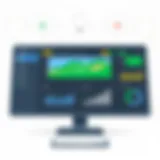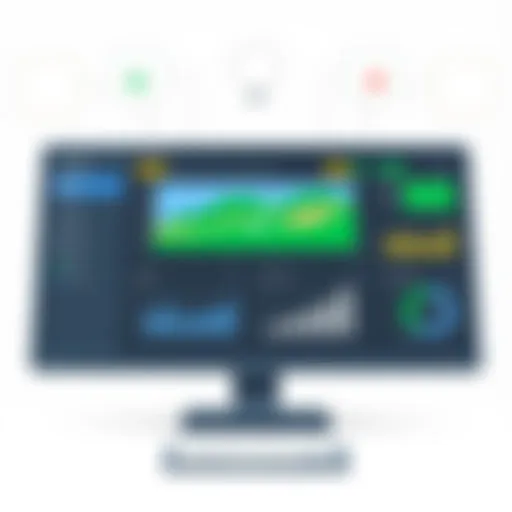Comparative Analysis of Top EMR Software Solutions


Intro
Navigating the waters of Electronic Medical Records (EMR) software can be a daunting task, especially for those tasked with making the final call. With a plethora of options, each boasting unique features and functionalities, it's crucial to understand how well these solutions align with the specific needs of healthcare organizations. The delicate balance between usability, compliance, and cost is often at stake, making this a decision that deserves careful consideration.
Understanding EMR software not only involves knowing what features are available but also how these systems integrate into daily operations. Some systems prioritize user interfaces that resemble a social media feed, while others take a more clinical approach. Moreover, there’s an entire industry built around compliance with various regulations that one must also scrutinize. With all these aspects in mind, let’s dive into a comprehensive overview that sets the stage for further analysis.
Software Overview
Brief Description of Software
At its core, EMR software serves to streamline patient data management. A prime example here is Epic Systems, widely known in the healthcare sector for its elaborate patient records system. Another notable platform is Cerner, which caters especially well to larger hospital networks looking for extensive customization. These solutions enable providers to document clinical information efficiently while ensuring regulatory requirements are met.
Key Features and Functionalities
When analyzing EMR software solutions, consider the following features:
- User-Friendly Interface: A simple, clean design is a must. Software with intuitive navigation allows healthcare professionals to focus more on patient care than on learning how to use the system.
- Interoperability: The ability to share patient information across different platforms is pivotal. Systems like Allscripts focus on this aspect, promoting seamless data exchange.
- Reporting Capabilities: Effective EMR solutions must offer robust reporting tools that allow users to generate insights from the data captured. This not only aids in clinical decision making but also in meeting regulatory reporting requirements.
- Customization Options: Healthcare settings vary widely. An ideal EMR system provides customization options to adapt to specific workflows.
- Data Security Features: Security in handling patient information is paramount, and EMR systems should offer advanced encryption and access controls to safeguard sensitive data.
Together, these features create a comprehensive ecosystem that can significantly enhance operational efficiency in healthcare settings.
Detailed Comparison
Comparison with Competitors
Once the options are identified, the next step is comparing each EMR solution with its competitors. For example, comparing Epic and Cerner can reveal crucial differences in their approach to user experience and customization options. Epic often ranks high for its deep integration and patient engagement features, while Cerner is frequently noted for its intuitive interface and ease of use. Understanding these nuances can help decision-makers select the right solution for their institution's unique needs.
Pricing Structure
Pricing models for EMR systems can vary widely, often depending on factors like features and scale of implementation.
- Subscription-Based: Some software, like Athenahealth, offers a subscription service, which may appeal to smaller practices looking for manageable monthly costs without hefty upfront investments.
- Perpetual License: Others, like Meditech, operate on a traditional license model requiring a larger upfront payment, which can be more economical in the long run for larger organizations.
Considering the total cost of ownership, including updates and support, is vital when evaluating these financial implications.
"The decision on EMR software can make or break the functioning of a healthcare organization. It's more than just software; it’s about improving patient care and operational efficiency at its core."
Preamble to EMR Software
In today’s healthcare landscape, the adoption of Electronic Medical Records (EMR) software is not merely a trend; it’s a necessity. EMR systems have become vital for healthcare organizations, facilitating the documentation and management of patient information. With an increasing reliance on technology, understanding how these systems work and their impact can empower decision-makers, IT professionals, and entrepreneurs to make informed choices about their healthcare software needs.
The purpose of EMR software goes beyond simple record-keeping. It streamlines workflows, enhances data accessibility, and improves communication among healthcare providers. Not only does this enhance patient care, but it also contributes to operational efficiency. As the healthcare sector becomes increasingly complex, the implications of integrating EMR systems cannot be understated.
Definition and Purpose
EMR software is a digital version of a patient�’s paper chart. It encompasses a wide range of functionalities that allow healthcare providers to manage clinical data more effectively. Unlike traditional record-keeping systems, EMRs provide real-time access to patient health information, which can be critical in emergency situations or for ongoing patient management. The primary purpose of EMR systems includes:
- Improving Patient Care: Quick access to patient histories, medications, and test results allows for better diagnosis and treatment.
- Streamlining Administrative Processes: Automating scheduling, billing, and reporting can reduce administrative burdens on staff, freeing them to focus on patient care.
- Enhancing Data Security: The software typically includes built-in security features to protect sensitive patient information, ensuring compliance with health regulations.
Historical Context
The journey of EMR software began in the 1960s when the first computerized medical records were developed. These primitive systems were costly and often cumbersome, mainly confined to large hospitals with significant financial resources. Fast forward to the late 20th century, EMR systems evolved alongside advancements in technology. By the 1980s and 1990s, the emergence of more user-friendly interfaces and cost-effective solutions made it possible for smaller practices to adopt EMRs.
The implementation of the Health Information Technology for Economic and Clinical Health (HITECH) Act in 2009 provided a major boost to the adoption of EMR software. Incentives were offered to healthcare providers who demonstrated meaningful use of electronic records, accelerating the transition from paper to digital. Nowadays, the market is saturated with various EMR software solutions, each claiming to offer unique features and efficiencies.
Thus, understanding the history and evolution of EMR software gives clarity on its importance in contemporary healthcare. The continued shift towards digital records is not just a passing phase but an integral aspect of modern healthcare operations.
Criteria for Comparison
When it comes to evaluating Electronic Medical Record (EMR) software solutions, understanding the criteria for comparison is crucial. The selection process can be overwhelming with the vast array of options available, so having a clear framework helps to simplify decision-making. The right EMR system should not only meet the basic needs of a healthcare organization but also align with its long-term goals and operational workflows.
A careful examination of criteria helps in identifying which features are necessary and how they truly impact overall efficiency. Effective EMR solutions enhance patient care, streamline operations, and reduce errors—all key aspects of a successful healthcare system. For decision-makers, focusing on specific elements encourages a proactive approach, ensuring that the chosen software keeps pace with both technological advancements and regulatory changes.
Feature Set
A comprehensive feature set includes a myriad of functionalities that cater to the specific needs of healthcare providers. Different software platforms come with an assortment of tools such as:
- Patient Registration: Automated systems for quick and efficient capture of patient data.
- Clinical Documentation: Tools that assist healthcare professionals in documenting patient encounters accurately.
- Appointment Scheduling: Features that allow for easy management of patient appointments.
- Billing and Coding: Integrated billing systems that simplify insurance claims and payments.
Choosing the right features ensures that the software supports clinical workflows efficiently while enhancing patient engagement and satisfaction. Software that offers customizable settings allows healthcare providers to tailor functionalities to their unique operational needs.
User Experience
User experience plays a pivotal role in the adoption and effective utilization of EMR systems. An intuitive interface can significantly reduce the learning curve for staff, ensuring a smoother transition from paper records to digital solutions. Some key considerations include:
- Intuitive Design: An interface that is easy to navigate ensures that users can find the information they need without frustration.
- Mobile Accessibility: Solutions offering mobile compatibility allow healthcare professionals to access critical patient data on-the-go, fostering better management of off-site patients.
- Real-time Analytics: Tools that provide real-time insights can be invaluable in driving informed decision-making and improving patient outcomes.
A positive user experience not only boosts staff satisfaction but also leads to improved patient interactions, making it indispensable in EMR software selection.


Compliance and Security
In an era where data breaches and regulatory scrutiny are rampant, compliance and security features of EMR software cannot be overlooked. The software must adhere to regulations governing the healthcare industry, especially HIPAA in the United States. Important aspects include:
- Data Encryption: Protecting sensitive patient information is paramount. Robust encryption technologies help safeguard data in transit and at rest.
- Access Controls: Role-based access ensures that only authorized personnel can view specific data sets, minimizing the risk of unauthorized access.
- Audit Trails: Monitoring who accesses patient data and when can help in ensuring compliance and identifying potential security breaches.
Maintaining high standards of compliance and security fosters trust with patients while safeguarding institutions against legal repercussions.
"Selecting an EMR software isn't just about functionality, but also about building a foundation of trust and security for patient data."
In summary, assessing the criteria for comparison when evaluating EMR software provides a thorough overview of what features, user experience, and security measures are essential for effective healthcare delivery. Each of these elements plays a vital role in ensuring that the software not only meets current needs but is also adaptable to future challenges.
Top EMR Software Solutions
In today's digital healthcare landscape, selecting the right Electronic Medical Record (EMR) software is crucial. Not just for improving efficiency, but also for enhancing patient care. Providers face a myriad of options, so understanding the strengths and weaknesses of leading solutions becomes an invaluable tool for decision-makers. The following sections will illuminate notable EMR software solutions that have stood out in the industry due to their robust functionality, user feedback, and pricing models, which play an essential role in guiding healthcare professionals toward making beneficial choices.
Software A: Overview
Key Features
Software A has carved a niche due to its impressive feature set, which includes advanced patient scheduling and seamless billing integration. One standout is its intuitive interface, which many users praise for significantly streamlining workflow—even for those who aren't tech-savvy. Its powerful reporting tools allow healthcare providers to generate analytics that can guide better decision making. While some might find the learning curve initially steep, the long-term benefits are hard to ignore.
User Feedback
The chatter among users about Software A is largely positive. Many highlight the responsive customer support as a game changer, helping them resolve issues quickly. However, it’s not all roses; a few users point out occasional glitches during peak usage. The organized feedback indicates that overall satisfaction ties closely to ongoing updates, which keep the software relevant and user-centric.
Pricing Options
When it comes to costs, Software A adopts a subscription-based pricing model. This can be advantageous because it allows facilities to avoid hefty upfront costs. However, users are advised to scrutinize long-term commitments as prices can escalate over time. A unique feature includes tiered pricing that can accommodate small clinics as well as larger healthcare systems, making it flexible but sometimes confusing.
Software B: Overview
Key Features
Moving on to Software B, its most notable feature lies within its customizability. Users can tailor dashboards and templates to meet specific clinical processes, providing personal relevance that resonates well with practitioners. The multi-language support is another impressive aspect which makes it a favored choice for diverse teams. Yet, the growing complexity might overwhelm users initially.
User Feedback
User feedback around Software B often emphasizes how adaptable the software is, especially for practices that cater to varied patient demographics. However, it's essential to note that while the adaptability is a boon, it also requires ample training for the team to harness its full potential. This dual nature—of flexibility and the need for training—raises important considerations for any prospective buyer.
Pricing Options
Pricing for Software B is relatively competitive, making it solid for organizations with budget constraints. It's been designed to work well with existing budget plans, which helps ease financial pressures. However, some users have found the a la carte nature of additional features to be tricky, as seemingly small add-ons can lead to significant costs down the line.
Software C: Overview
Key Features
Software C excels in its user-friendly design, making navigation a breeze. This characteristic alone could justify its adoption, particularly among healthcare users who might be apprehensive about tech. Its integrated telemedicine capabilities stand out, particularly in today's world where remote consultations are in demand. Nonetheless, a few reviews do flag occasional performance lags in specific functionalities.
User Feedback
The takeaway from Software C's user feedback is overwhelmingly optimistic. Practitioners appreciate how quickly they can reach the support team, minimizing downtime. Users do mention a few functions they believe could benefit from additional refinement. This candid feedback demonstrates that while the software excels in many areas, there's still room to grow.
Pricing Options
Software C utilizes a flat-rate pricing model. This simplicity aids many buyers in gauging baseline costs without unexpected additions. Although this might appeal to some, others note that such a model may prove less cost-effective for smaller practices that use fewer features.
"Choosing the correct EMR software is not just a matter of convenience; it's about redefining the standard of care delivered to patients."
Integration Capabilities
In the current landscape of healthcare technology, the significance of Integration Capabilities cannot be overstated. These capabilities determine how well electronic medical records (EMR) systems can communicate and operate with other healthcare software and systems. This integration is essential for a seamless flow of information, which ultimately enhances patient care and operational efficiency.
Below are several crucial aspects that illustrate the importance of integration capabilities within EMR solutions:
- Improved Care Coordination: When providers can share patient data across systems, it leads to more coordinated care. Patients often see multiple specialists, and having everyone on the same page helps avoid duplication of tests and improves overall treatment plans.
- Real-Time Data Access: With integration, healthcare professionals can access patient information in real-time, enabling quicker decision-making. If a nurse needs to review a patient’s medication history, integrated systems expedite this process, reducing wait times and enhancing patient satisfaction.
- Data Accuracy: Integration minimizes errors that might occur when transferring data manually between systems. By ensuring that systems synchronize automatically, the chances of outdated or incorrect information being used are substantially reduced.
- Cost Efficiency: Organizations save time and resources when their technologies work together. Incompatible systems can lead to expensive workarounds and loss of productivity. Integrated EMR solutions often lead to better financial management through more efficient billing processes and minimized paperwork.
"An EMR system that works well with others is not just a tool; it’s a partner in improving healthcare outcomes."
Navigating the complex world of integration capabilities can make a significant difference for healthcare providers aiming to choose an EMR solution that fits their unique landscape.
Interoperability Issues
The road to interoperability in healthcare has many bumps. Each EMR system often has its own peculiar ways of operating. Without standardized communication protocols, issues arise when trying to connect different systems.
Common interoperability challenges include:


- Variation in Data Standards: Different EMR vendors may use distinct formats for storing data. These discrepancies create barriers for systems trying to communicate.
- Lack of Comprehensive APIs: Some EMR vendors may provide limited Application Programming Interfaces (APIs), hindering other systems from negotiating smoothly.
- Resistance to Change: Sometimes, existing institutions are reluctant to overhaul systems for better integration capabilities.
Such issues underscore why evaluating interoperability should be a top priority for healthcare professionals considering EMR solutions.
Data Exchange Standards
Data exchange standards serve as the backbone for successful integration in healthcare systems. Having a set of guidelines ensures that data can be shared seamlessly among various software applications. The importance of established data exchange standards cannot be ignored. Some key points are:
- HL7 and FHIR: Health Level Seven (HL7) and Fast Healthcare Interoperability Resources (FHIR) are two key standards that facilitate data exchange. They allow for consistent formatting of health information which simplifies sharing across different EMR systems.
- Diverse Data Types: Medical information can include structured data (like lab results) and unstructured data (like doctor's notes). Good standards allow both forms to be exchanged without issues.
- Regulatory Compliance: Many standards are designed to comply with governmental regulations, ensuring that patient data is handled responsibly and protects patient privacy.
Ensuring adherence to these data exchange standards not only benefits individual systems but also promotes a more interconnected healthcare environment.
Deployment Methodologies
Deployment methodologies are crucial in the landscape of Electronic Medical Records (EMR) software. Choosing the right deployment method can significantly impact the performance, scalability, and overall usability of the EMR system within a healthcare organization. Heads up, the decision rests not just on preferences but also on specific operational needs and IT resources. Understanding these methodologies ensures that healthcare professionals and decision-makers make informed choices about EMR software that align with both clinical and business goals.
Cloud-Based Solutions
Cloud-based EMR solutions have gained traction over the years due to their flexibility and cost-effectiveness. With these systems, data is stored on remote servers, accessible via the internet. This method specifically caters to organizations that prefer reduced upfront capital expenditure and ongoing maintenance costs. The benefits of cloud solutions include:
- Scalability: It's easier for healthcare organizations to scale operations without the heavy investment in physical infrastructure.
- Remote Access: Providers can access patient records from anywhere, enhancing care delivery, especially in remote areas.
- Automatic Updates: Most cloud providers roll out software updates automatically, meaning users are always working on the latest version.
However, security is a key consideration. Just because it’s “in the cloud” doesn’t mean it’s entirely secure. Organizations must ensure that chosen vendors comply with regulations like HIPAA to protect patient data.
On-Premises Solutions
On-premises solutions require the EMR software to be installed on local servers within the organization. This choice generally appeals to larger organizations that want greater control over their data. The benefits include:
- Enhanced Security: Having data on-premises can sometimes offer stronger security measures, depending on the organization's infrastructure.
- Customization: Organizations can tailor systems more specifically to their operational processes and workflows.
- Data Ownership: Control over patient data remains solely in the hands of the organization, avoiding potential issues with external providers.
That said, on-premises solutions also come with their challenges. The upfront costs can be steep and ongoing maintenance requires dedicated IT personnel. Additionally, without remote access, it can limit the flexibility that modern healthcare increasingly demands.
In summary, both deployment methodologies have their pros and cons. Ultimately, the choice will depend on an organization's specific needs, budget constraints, and security considerations. Caution and due diligence are key when deciding the best pathway for EMR implementation.
"The right deployment methodology is not about what is trending; it's aboutwhat aligns best with your organization's goals and capabilities."
Cost Analysis
In the realm of Electronic Medical Records (EMR) software, financial considerations hold significant weight. Cost analysis is not merely about the sticker price but encompasses a broader perspective that evaluates the overall financial impact on healthcare facilities. For decision-makers, understanding how these costs unfold can dramatically influence the choice of software, which in turn affects operational efficiency and patient care quality.
By dissecting the financial components of EMR systems, stakeholders can uncover valuable insights that aid in making an informed decision. A thoughtful cost analysis can reveal potential hidden expenses, such as maintenance, training, and future upgrades, which may complicate a straightforward pricing comparison. With the stakes being quite high in healthcare, where every dollar is accounted and must deliver value, this section is imperative for anyone looking to invest in EMR solutions.
Pricing Models
Pricing models can vary between different EMR vendors, and understanding these can make or break a budget. There are typically three primary types of pricing structures:
- Perpetual License: This model requires a one-time purchase fee, allowing the healthcare facility to own the software indefinitely. However, ongoing costs for updates and support can add up over time.
- Subscription-Based: Here, the facility pays a recurring fee, which may seem appealing as it spreads costs out over time. These fees often cover updates and support, making budgeting more predictable, although they accumulate over the years.
- Pay-Per-Use: Primarily aimed at facilities looking for flexibility, this model charges based on actual usage. While this can be economical for lower volume practices, it's essential to consider the long-term potential of costs if usage increases.
In summary, each pricing model has its pros and cons. The right choice hinges on the specific needs and financial structure of the healthcare provider.
Total Cost of Ownership
Total cost of ownership (TCO) takes cost analysis a step further by considering not just the initial pricing model, but all associated expenses incurred throughout the lifecycle of the EMR system. Evaluating TCO provides a comprehensive outlook, allowing entities to ascertain the true financial commitment involved. Some critical factors to consider include:
- Implementation Costs: This encompasses customization, installation, and the technical effort required to get the system up and running.
- Training Expenses: There’s often a need for thorough training to ensure that staff can use the system effectively. The quality of training provided can also impact the overall costs, as poor training can lead to inefficiency.
- Maintenance and Support: Regular maintenance, technical support, and system upgrades are ongoing costs that should be crafted into the TCO equation.
- Downtime and Transition Costs: Any system migration or transition may incur hidden costs due to temporary inefficiencies or service interruption.
- Regulatory Compliance: Staying compliant with healthcare regulations often requires additional resources that may not be evident upfront.
As portrayed, a meticulous approach to assessing total cost of ownership not only helps in understanding the financial implications but also aids in selecting a system that aligns with budget constraints and operational goals.
Regulatory Considerations
In the intricate realm of Electronic Medical Records (EMR) software, regulatory considerations hold immense weight. They are not just boxes to tick off but crucial elements that ensure the safety, privacy, and integrity of patient information. In a landscape where data breaches can lead to severe reputational damage and financial penalties, understanding the regulatory framework becomes imperative for healthcare providers, IT professionals, and decision-makers.
HIPAA Compliance
One of the cornerstones of regulatory considerations in the U.S. healthcare system is the Health Insurance Portability and Accountability Act, commonly known as HIPAA. HIPAA sets the standard for protecting sensitive patient information. For EMR software, compliance with HIPAA is non-negotiable.
Key aspects of HIPAA compliance include:
- Privacy Rule: This regulates how covered entities can use and disclose protected health information (PHI).
- Security Rule: This mandates a set of security standards to ensure the confidentiality, integrity, and availability of electronic PHI.
- Breach Notification Rule: It requires covered entities to notify patients when their PHI has been compromised.
Failure to comply can lead to hefty fines and even criminal charges, depending on the severity of the breach. Therefore, when evaluating EMR software, it is essential to scrutinize how thoroughly a vendor adheres to HIPAA guidelines. Does the vendor offer encryptions for data in transit and at rest? Are their staff sufficiently trained on compliance matters? These are critical questions for any healthcare organization.
State-Specific Regulations
Beyond federal regulations, each state can impose its own set of rules regarding how medical records must be handled. This adds another layer of complexity for healthcare providers looking to adopt EMR solutions. For instance, certain states may have stricter privacy laws than HIPAA, or they might specify additional security measures that must be implemented.
Some considerations include:


- Data Retention Laws: How long must medical records be kept? States often have varied requirements, impacting data storage solutions.
- Patient Right to Access: Many states allow patients enhanced access to their own medical records, thus impacting how EMR systems should manage and present data.
- Telemedicine Regulations: The rise of virtual healthcare has led states to create regulations that govern how patient data is shared through telemedicine platforms.
Understanding these state-specific regulations ensures that healthcare providers remain compliant and offer quality service while avoiding legal pitfalls. Every EMR software solution must be evaluated not just through the lens of federal compliance but with an awareness of local regulations, fortifying patient trust in an organization’s commitment to safeguarding their sensitive information.
User Training and Support
Training and support are the backbone of effectively implementing any EMR software solution. User training ensures that healthcare staff, who often juggle multiple responsibilities, can navigate the system with ease and proficiency. Moreover, as EMR systems are becoming increasingly complex, a well-structured training program can lead to smoother transitions and enhanced adoption rates among personnel. Empowering users not only minimizes errors and maximizes productivity but also enhances the overall patient experience, as practitioners can focus more on care rather than troubleshooting software issues.
Support systems complement this training. They offer continuous assistance and address ongoing inquiries or concerns that arise as staff become more familiar with the software. A lack of appropriate support can create frustration, lead to disengagement, and ultimately hinder the effectiveness of the EMR system. Hence, focusing on robust user training and sound support mechanisms is vital for healthcare organizations looking to capitalize on their EMR investments.
Training Programs Offered
When considering EMR solutions, it's essential to evaluate the training programs provided by vendors. Many companies offer a variety of approaches, including:
- On-Site Training: Personalized instruction on how to use the system effectively, tailored to specific workflows within a medical facility.
- Webinars and Online Tutorials: Flexible learning options for staff, allowing them to engage with training materials at their own pace.
- Interactive Workshops: Hands-on sessions that not only teach the software usage but also encourage collaboration among users to solve common challenges.
- Certification Programs: Some software vendors offer certification courses which can equip users with advanced knowledge of the EMR capabilities, enabling them to become internal experts.
Offering a combination of these training styles meets varied learning preferences within teams and encourages comprehensive understanding, making staff feel confident in their abilities to use the system.
Support Systems
Support systems must be robust and accessible, as they are an integral aspect of user training. Good support can drastically affect the total experience with the EMR system. Here are various aspects to consider when evaluating support offerings:
- 24/7 Help Desk: A round-the-clock support line can be critical in a healthcare setting where issues must be addressed promptly to maintain patient care.
- Online Knowledge Base: Resources like articles and FAQs allow users to find immediate answers independently, reducing downtime.
- Dedicated Account Managers: Having a primary point of contact can make communications smoother and foster a closer relationship between the vendor and the organization.
- Regular Software Updates and Maintenance: Updating software not only helps in maintaining compliance but also ensures that users have access to the latest features and improvements.
"A support system that is available, responsive, and understanding transforms frustrations into confidence, ensuring that users can maximize the value of their EMR software."
In summary, effective user training complemented by a strong support system is essential for realizing the full potential of EMR software solutions. It helps healthcare professionals optimize their time and focus on delivering high-quality care.
Future Trends in EMR Software
The landscape of Electronic Medical Records (EMR) is evolving swiftly, propelled by technological advancements and shifting paradigms in patient care. Embracing these future trends is not merely an option for healthcare providers; it has become a necessity. As healthcare professionals and decision-makers navigate these waters, understanding the significance of these trends becomes crucial for long-term success and adaptability.
Artificial Intelligence Integration
Artificial Intelligence (AI) has emerged as a game-changer in the healthcare sector, particularly in EMR software. By leveraging AI, EMR systems can analyze vast amounts of data with ease, identifying patterns and trends that are otherwise invisible to the human eye. This capability not only enhances diagnostic accuracy but also improves clinical decision-making.
With features such as predictive analytics, AI can help in anticipating patient needs, thus improving outcomes and optimizing resource allocation. Take for instance systems like Epic, which are beginning to incorporate AI algorithms to assist in clinical documentation. As clinicians input data, the AI analyzes context and suggests relevant information, streamlining the documentation process.
Furthermore, AI can assist in reducing administrative burdens by automating repetitive tasks, enabling healthcare professionals to focus more on patient care. This is particularly beneficial in busy environments where time is a precious commodity. While some might raise concerns about data privacy and ethical implications, the potential for improved healthcare delivery through AI integration remains a compelling argument.
Patient-Centric Approaches
Shifting towards patient-centered care has become a foundational principle in modern healthcare. EMR systems are increasingly designed to support this approach by prioritizing the patient's experience and involvement in their own care journey.
What does this mean in practical terms? Having the capability to provide patients access to their own medical records promotes transparency and empowers individuals to participate actively in decision-making. Systems such as MyChart facilitate this empowerment by allowing patients to review their test results, request prescription refills, and communicate directly with their healthcare providers.
Furthermore, the integration of telehealth features into EMR systems is another direct response to patient preferences. During and post-pandemic, many patients expressed a desire for remote healthcare options. EMR solutions that incorporate telehealth capabilities meet this need while providing continuity of care.
Important Considerations
- Integrating patient-centric features requires careful consideration of user interface and experience (UI/UX) design;
- It is essential that software developers engage both healthcare providers and patients to understand their needs better.
- Training staff on how to use these patient features effectively will enhance their adoption.
The transition toward patient-centric EMR systems signifies a major shift in how care is delivered, ultimately nurturing a healthier provider-patient relationship while improving health outcomes.
In Summary
Future trends in EMR software, particularly AI integration and patient-centric approaches, represent significant advancements that can reshape the healthcare experience. As these trends continue to develop, attentiveness to their implications will be crucial for both providers and patients, ensuring a more interconnected and efficient healthcare landscape.
Culmination
The conclusion serves as a pivotal moment in this comprehensive exploration of EMR software solutions. It functions not merely as a summary, but as a lens through which all previously discussed elements coalesce into actionable insights. More than just a wrap-up, this section underscores the significance of informed decision-making in choosing the right EMR system.
One of the primary findings throughout the analysis is the critical nature of aligning the chosen EMR software with specific business needs. Advisors and stakeholders must closely consider feature sets that cater to particular healthcare environments, whether that be small clinics or large hospitals. Each setting has distinct requirements, and failing to recognize this can lead to inefficiencies that might be financially detrimental.
In terms of user experience, the feedback collected from healthcare professionals has shown that a system’s usability directly correlates with staff satisfaction and patient care outcomes. IT departments should pay heed to this feedback as they sift through myriad options in the software market. Ultimately, a user-friendly interface can dramatically decrease training time and improve overall workflow.
Furthermore, the regulatory landscape underscores the importance of compliance, particularly with HIPAA regulations. Choosing software that not only meets but excels in maintaining compliance can protect organizations from costly penalties and enhance patient trust.
Hence, the conclusion invites readers to not only recall the specific features and benefits outlined but also to internalize the larger narrative of how these factors collectively influence operational success. It crafts a roadmap that advisors and decision-makers should follow when navigating the convoluted waters of EMR software selection.
Summary of Findings
Throughout this article, key findings surface that should guide decision-making in EMR software selection:
- Feature Functionality: Different software solutions offer varying feature sets that cater to distinct clinical needs. Importance lies in identifying priorities, such as telehealth capabilities, scheduling tools, and electronic prescribing features.
- User Feedback: Feedback from actual users highlights the critical importance of usability and adaptability, which can significantly influence day-to-day operations.
- Regulatory Adherence: Compliance with laws like HIPAA is paramount, ensuring that patient data remains secure and that healthcare providers avoid legal pitfalls.
"Selecting the right EMR is not just a choice; it's a commitment to better healthcare outcomes."
Recommendations for Advisors
For advisors in the healthcare sector, the following recommendations can be beneficial in the EMR selection process:
- Conduct Thorough Research: Take the time to research each software provider in detail. Look beyond marketing materials and seek unbiased reviews from peer healthcare providers.
- Engage Stakeholders: Include frontline staff in the evaluation process. Their insights into daily workflows can uncover critical needs that may not be immediately apparent.
- Evaluate Training and Support: Ensure the chosen provider offers robust training programs and ongoing support. A software’s success is often determined by how well users are trained to utilize it effectively.
- Pilot Programs: Where possible, run a pilot program. This allows for firsthand experience with the software's functionality and gives insight into its adaptability within your organization.
- Cost Analysis: Don't just look at upfront costs. Consider the total cost of ownership which includes maintenance, updates, and support services to make a well-rounded financial decision.
By following these recommendations, advisors will be better equipped to navigate the complexities of EMR software solutions, ensuring they select a product that meets both immediate needs and long-term goals.







